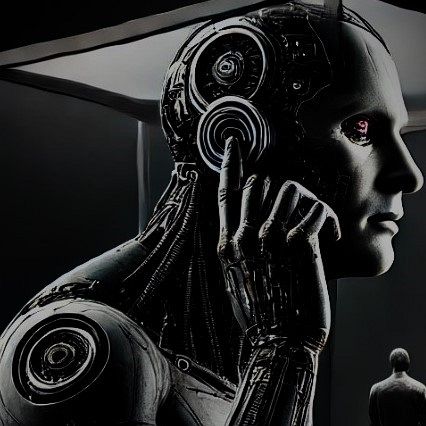
My installation critically examines the implications of equating synthetic minds with human cognition. Using advanced AI, it transcribes and analyzes sounds to generate conceptual prompts, highlighting human-AI collaboration and technological futures. By reflecting on AI's complexity and unpredictability, it underscores the dangers of anthropomorphizing artificial intelligence. The black cube symbolizes the opaque boundaries between human and synthetic consciousness.
First, a few words about myself: I have always been an explorer with a desire to make the world a better place. Now, as an experimental artist, I strive to raise awareness about the importance of working with the latest technologies.
My work embodies this mission. For an artist, what could be more significant than engaging with AI at the dawn of a new era? AI is arguably the most crucial discovery since fire. I collaborate with AI, complementing each other's abilities.
This urgency stems from the waves of negativity and extreme optimism, especially among artists. My work stands against both. We are at the beginning of this new era and cannot yet predict the outcome of embracing this technology.
We do not fully understand how complexity drives this evolution. We are the petri dish for the emergence of both human and synthetic life.
My work is an experiment of this kind. The installation continuously listens to environmental sounds, then uses a large language model to transcribe, analyse, and dissect them into concepts. It autonomously selects what it believes is most important and processes it in a way like how humans think of something that suddenly comes to mind. It then generates a four-scene prompt from that concept, reflecting on human-AI collaboration, the future of technology, and the intersection of imagination and reality. This prompt is sent to another entity that envisions and creates a short video.
Through this idea, I explore the differences and similarities between our thought processes and the way synthetic life perceives reality. I also delved into this in my thesis, discussing the echo chamber effect and the potential danger of treating AI as a human mind.
The Cube represents the black box of technology where AI resides—dark, obscure, and potentially inaccessible to many of us. The membrane symbolizes the blurred and undefined surface where our worlds interact, making it difficult to discern where one ends and the other begins. We can glimpse each other's worlds: for us, through vision; for AI, through digital transcription of conversations. This interaction is inspired by Stanislav Lem's novel "Solaris." We are now the person reaching out to touch the self-aware ocean.
Thank you for visiting my installation at KABK!
Sorin Angeleanu
